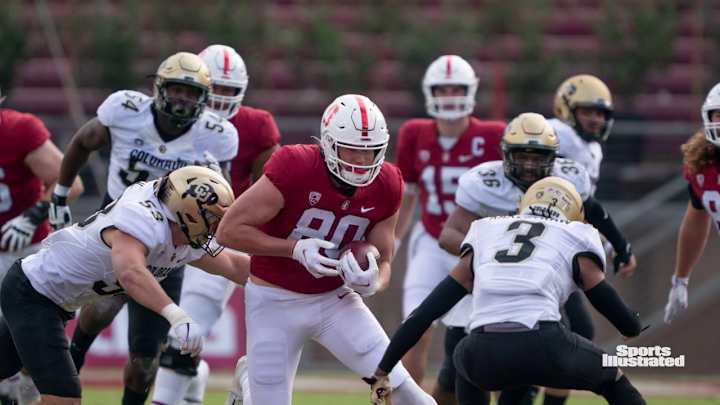How Bears Go About Stocking Tight End Position

In a Wednesday OTA practice last week, the Bears had receptions during non-contact work against the defense from tight ends Scooter Harrington, Darion Clark and J.P. Holtz.
The other reserve tight end on their roster is Jesper Horsted, who has already started a game and appeared in six.
These were their options for the third tight end position, and if there is one among them to be labeled an intriguing player it could be Harrington.
It seemed logical at some point they might make a trade or sign another third tight end candidate because the possibilities they're looking at are low on experience to say the least. It still is a possible consideration for a veteran waiver wire pick up after roster cuts.
Holtz actually is more of a fullback/fourth tight end already and not a third tight end candidate, although they could use him in this role if necessary. The Bears really have pigeon-holed him as a Y-tight end, the in-line spot where blocking is more important and routes downfield are fewer.
"He does a fine job as an in-line blocking tight end," tight ends coach Clancy Barone said. "He does a really nice job when he plays the fullback role as well."
The Bears have used Holtz very little. He was on the field last season for only 8% of the offensive snaps, 87 total, and his major contribution was taking nearly half the special teams plays.
What to do then when they need reserve pass production at U-tight end, the move position Jimmy Graham plays?
Horsted would rank as the key right now. Has he adapted to a change from college wide receiver to pro tight end to a point where he can contribute if called upon as the third tight end?
Usually three-tight end packages are deployed in games when a team is in short yardage, so the need then is for an extra blocker and not a third tight end receiving threat. Holtz would fit this, but at 6-foot-3, 240 pounds he might be a willing and able blocker but not the biggest extra player to uproot defenders for short yardage.
The team gave up on Clark on Sunday and cut him. He was the former college basketball player turned into a project last year and they apparently couldn't make a Jimmy Graham type of him.
Harrington is ideal size at 6-5, 250, and the Stanford undrafted rookie already had a national reputation. He figured to some day be an NFL tight end. He was a four-star recruit coming out of high school, the second-rated player at his position then and someone who was considered an all-around tight end.
"I'm different from other tight ends because I can go down the field and catch balls, but I pride myself on being a blocker," he told USA Today when he was coming into college.
Harrington committed to Boston College, where his father had played. Then he switched to Stanford, a well-known producer of pro tight ends much like Boston College. But he was overshadowed at Stanford by 6-7 tight end Colby Parkinson and barely was used in his 42 games as a receiver until 2020, when he had 17 receptions for only a 6.1-yard average and two TDs.
With his size and background at the position, there is a real opportunity for Harrington to show he can contribute in a way like former Bears tight end Ben Braunecker did as an undrafted free agent.
Stanford TE Scooter Harrington (#80) vs. Southern California (09/08/18). #NFLDraft pic.twitter.com/Bs7FG3bRm7
— PFDZ (@PFDZ44) June 29, 2019
Last year the Bears gave third tight end Demetrius Harris 215 offensive snaps, or 20% of the total. It was the smallest snap total he had since his rookie season.
His contribution dropped greatly as the role of Cole Kmet increased throughout the season.
Barring injuries, the Bears could probably get by with Kmet, Graham and Holtz, using any of the others as a fourth or the backup U-tight end. The ideal situation, though, would be for an all-purpose type to step forward who could play either tight end position.
The player deemed the backup at the U-tight end has a future chance to grow into a larger role because Graham is in the final year of his contract and turns 35 this season.
Special teams is the key for the others. Harris got on the field for 169 special teams snaps, or 37%.
The Bears have plenty of other issues with their roster more pressing than a third or fourth tight end, but a shortage of tight ends has burned them as recently as 2019.
It could again unless one of these younger, inexperienced players steps up in training camp to show they can be of value now and in the future.
Twitter: BearDigest@BearsOnMaven

Gene Chamberlain has covered the Chicago Bears full time as a beat writer since 1994 and prior to this on a part-time basis for 10 years. He covered the Bears as a beat writer for Suburban Chicago Newspapers, the Daily Southtown, Copley News Service and has been a contributor for the Daily Herald, the Associated Press, Bear Report, CBS Sports.com and The Sporting News. He also has worked a prep sports writer for Tribune Newspapers and Sun-Times newspapers.